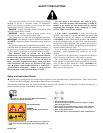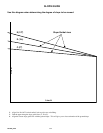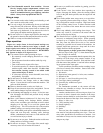4-2 601396_0109
V Clean flammable material from machine. Prevent
fires by keeping engine compartment, exhaust area,
battery, fuel line, fuel tank and operator’s station
clean of accumulated trash, grass clippings, and other
debris. Always clean up spilled fuel and oil.
Using a ramp
V Use extreme caution when loading and unloading a unit
onto a truck or trailer with a ramp.
V Use only a single, full width ramp; do not use individual
ramps for each side of the unit. Having a full width ramp
provides a surface for the tractor frame to contact if the
unit starts to tip backwards. It also reduces the risk of a
wheel going off and the machine tipping over.
V Do not exceed a 15 degree angle between the ramp and
the ground or between the ramp and the trailer or truck.
V When on a ramp avoid sudden acceleration
Slope operation
Slopes are a major factor in loss-of-control and tip-over
accidents, which can result in severe injury or death. All
slopes require extra caution. If you cannot back up the slope
or if you feel uneasy on it; do not mow it. REMINDER:
Only operate on slopes of 15 degrees or less.
V Use extreme caution when operating on slopes.
• Be extremely careful changing directions on a slope.
Slow down.
• Do not operate where the machine could slip or tip.
• Turn slowly
• Turn on the most level part of the slope
• To maximize traction, it is better to turn the front of the
machine uphill, rather than downhill. If drive tires
lose traction, steering control is lost which could
cause serious injury or death.
• If it becomes necessary to turn downhill, turn slowly
and gradually, if possible.
V Do not remove or modify the stabilizer wheels.
V Watch for holes, ruts, bumps, rocks or other hidden
objects. Uneven terrain could overturn the machine. Tall
grass can hide obstacles.
V Remove obstacles such as rocks, tree limbs, etc.
V Keep all movement on slopes slow and gradual. Do not
make sudden changes in speed or direction.
V Avoid starting and stopping on a slope. If tires lose trac-
tion, disengage the blades and proceed slowly straight
down the slope.
V Mow a safe distance (minimum of 10 feet) away from
drop-offs, retaining walls, drainage ditches, embank-
ments, water, and other types of hazards to avoid a wheel
dropping over the edge or to avoid the ground from
breaking away. This will reduce the risk of the machine
suddenly rolling over causing serious injury or death.
V Use a walk behind, push mower or hand-held trimmer on
slopes and near drop-offs, retaining walls, drainage
ditches, embankments and water to avoid machine roll-
over and serious injury or death.
V Do not mow on wet grass. Reduced traction could cause
sliding and loss of steering control.
V Do not tow on slopes. The weight of the towed equip-
ment may cause loss of traction and control.
V Do not try to stabilize the machine by putting your foot
on the ground.
V If the mower’s tires lose traction when operating on
slopes, disengage the blades, place the steering control
levers in the park brake position, turn the engine off and
get help.
V Never make sudden starts, stops, turns, or reverse direc-
tion, especially when maneuvering on slopes. The steer-
ing is designed for sensitive response. Rapid movement
of the steering control levers in either direction could
result in a reaction of the tractor that can cause serious
injury.
V Never stop suddenly while backing down slopes. This
action may result in a reaction of the tractor that can
cause serious physical injury.
V The Hustler mower is capable of operating horizontally
(traverse) on moderately steep slopes. When operating
on slopes up to 15 degrees, be aware of any conditions
that may cause the tractor drive tires to lose traction
resulting in a possible loss of control of the machine. An
operator should not operate on a slope until he is thor-
oughly familiar with the equipment.
Do not operate on slopes greater than 15 degrees.
Refer to Slope Guide, page 3-3, when determining the
degree of slope to be mowed.
It is strongly recommended that the operator drive the
machine off of the slope, using extreme caution, if any
sign of loss of traction is detected. Wait until the condi-
tion that caused the problem is resolved before attempt-
ing to operate on the slope again.
Terrain conditions can affect traction resulting in pos-
sible loss of control of the machine. Some of the condi-
tions to be aware of are:
1. Wet terrain
2. Depressions in the ground; i.e. holes, ruts, washouts
3. Mounds of dirt
4. Soil type; i.e. sand, loose dirt, gravel, clay
5. Grass type, density, and height
6.
Extremely dry conditions of grass
7. Tire pressure
The attachments mounted to the tractor will also
affect the way it handles on a slope. Be aware that each
attachment’s characteristics vary.
Another consideration to safe mowing on slopes is to
be aware of what is located at the bottom of the slope.
Extreme caution should be used when there is a hazard
located at the bottom of the slope. Some examples are:
1. Water; i.e. lake, river
2. Cliffs, retaining walls
3. Roads, highways
4. Buildings
5. Rocks
These are just a few examples of situations when cau-
tion must be used when operating on a slope. There are
many other possibilities too numerous to mention. Just
remember to always exercise extreme caution when oper-
ating on any slope.


















